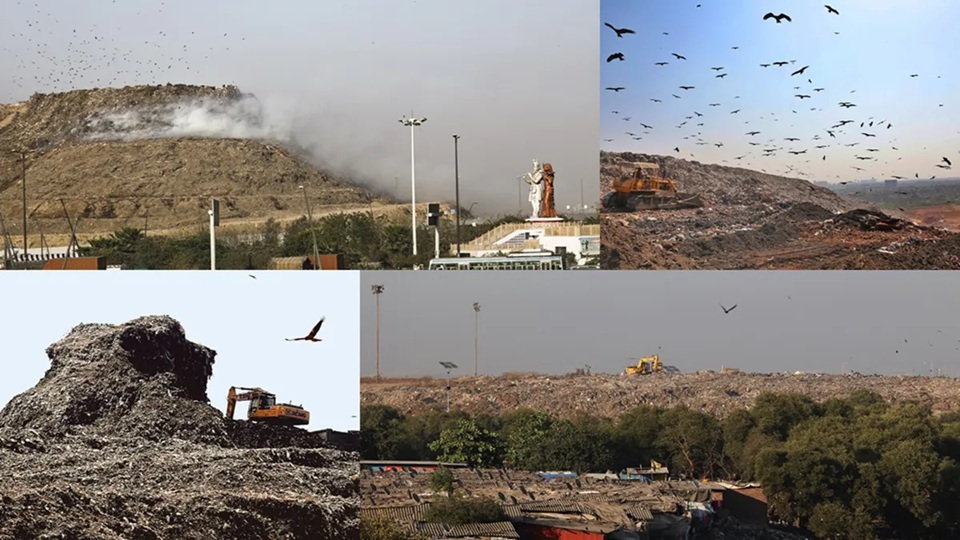In the heart of East Delhi stands an ominous and ever-growing symbol of urban mismanagement—the Ghazipur landfill. Often referred to as “Delhi’s Garbage Mountain,” this colossal waste heap has not only transformed the skyline of the area but also become a daily nightmare for thousands of residents living nearby. Rising over 65 meters high—taller than many buildings in the city—the landfill is a stark reminder of the capital’s struggle with waste disposal and environmental neglect.
A Landmark of Waste
The Ghazipur landfill was commissioned in 1984 and was officially declared full in 2002. However, the dumping of waste never stopped. Every day, more than 2,000 tonnes of garbage are dumped at the site, even though it has long exceeded its capacity. Over the decades, the landfill has grown taller and more dangerous, threatening nearby communities with pollution, health risks, and even physical collapse.
In 2017, a portion of the landfill collapsed during heavy rains, killing two people and pushing vehicles off the road into a nearby canal. That tragic incident was a wake-up call—but years later, not much has changed.
The Daily Struggles of Nearby Residents
For the people living in nearby areas like Ghazipur village, Khoda Colony, and Kondli, life next to the landfill is filled with hardship. The stench of rotting garbage, rising methane fumes, and clouds of dust are constant companions. Breathing difficulties, skin infections, eye irritation, and gastrointestinal diseases are widespread among residents—especially children and the elderly.
Meena Kumari, a 34-year-old homemaker living in the area, says, “We keep our windows shut throughout the day. Even then, the foul smell enters our homes. Children fall sick often, and the doctors blame the polluted air.”
Flies, stray animals, and mosquitoes swarm the region, making it nearly impossible to live a normal life. The monsoon season adds another layer of danger, as rains can trigger landslides from the unstable garbage mound. The local groundwater has also been contaminated by leachate—a toxic liquid that seeps out of decomposing waste—making it unsafe to drink or even use for washing.
Government Measures: Progress or Patchwork?
The government has made several attempts to address the Ghazipur landfill crisis, but progress has been slow and often inconsistent.
In 2019, the East Delhi Municipal Corporation (EDMC) launched a biomining and bioremediation project to treat the legacy waste. The objective was to segregate old waste into biodegradable, recyclable, and inert categories using trommel machines. These machines sift through the mountain, separating waste into components that can be processed or reused. The initiative aimed to reduce the height of the landfill and reclaim land for public use.
As of 2024, around 30-35% of the legacy waste has been processed, but the pace is far from adequate. With new waste still being dumped daily, the reduction in height has been negligible.
A proposed waste-to-energy (WTE) plant near the site was expected to convert trash into electricity, but environmentalists have raised concerns over the emission of toxic gases and ash residues. Furthermore, the plant is operating below its expected capacity due to inefficient waste segregation at source.
Delhi’s civic agencies have also introduced plans to promote door-to-door waste segregation, composting of kitchen waste, and recycling initiatives. However, implementation is spotty, and public awareness remains low. Without strict enforcement and community participation, these efforts are unlikely to yield lasting results.
Local Sentiments: Frustration and Fear
Residents around the landfill have repeatedly protested, submitted petitions, and approached local leaders demanding action. Many feel ignored by the authorities.
Ravi Singh, a shopkeeper in the area, explains, “They promise us every year that the dump will be cleared, but it only grows taller. We are paying the price for the city’s garbage.”
People living near Ghazipur often face social stigma as well. Property values in the area have plummeted, and health insurance premiums are reportedly higher due to the toxic environment. Children growing up near the landfill are at increased risk of developing chronic illnesses, affecting their long-term well-being.
What Needs to Change
The Ghazipur landfill is not just a Delhi problem—it reflects a national crisis. According to the Central Pollution Control Board, India generates over 150,000 tonnes of municipal solid waste every day. Most cities lack the infrastructure to manage this effectively.
Key solutions to this crisis must include:
Strict waste segregation at source: Households and businesses must be mandated—and educated—to separate biodegradable and non-biodegradable waste.
Investment in modern waste processing plants: Facilities that safely recycle, compost, and convert waste to energy are crucial.
Community involvement: Public awareness campaigns and civic participation are necessary for sustainable change.
Ban on dumping fresh waste at legacy sites: Landfills like Ghazipur should no longer receive new waste; instead, new scientific landfills must be developed with proper lining and leachate management systems.
A Mountain That Should Never Have Been
The Ghazipur landfill is a towering example of what can happen when urban growth outpaces planning and policy enforcement. It is a threat to public health, an eyesore for the city, and an ecological time bomb. And unless urgent and sustained action is taken, Delhi may soon find itself surrounded by more such mountains.
The government must move beyond half-measures, and citizens must demand accountability and act responsibly. Only then can Delhi begin to dismantle this monument to waste and replace it with a cleaner, safer future.
